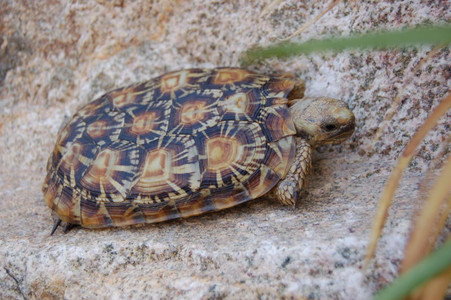- Home
- Tortoises For Sale
- Pancake Tortoises For Sale
- Pancake Tortoise
- Home
- Tortoises For Sale
- Pet Tortoises For Sale - 4" Size or Larger
- Pancake Tortoise
Product Reviews
-
Amazing

Posted by Unknown on 1st Feb 2011
I love My pancakes they are facinating, there very active and eat like pigs!
-
My Favorates

Posted by Unknown on 27th Jun 2010
In the past year I have boutght one male and one female pancake tortoises from Tortoise Supply. They were shipped well, and both began eating within minutes of taking them out of the box. They're vibrant and are definitely the most beautiful pancake tortoises I have ever seen.
-
I love mine

Posted by Unknown on 24th May 2010
I have two pancake tortoises and they are my favorite out of all of my reptiles. Tortoise supply was very helpful and answered all of my emails within a day, and gave me the confidence to purchase one and another one later. I am very pleased with my tortoises and the help I received.
Description
Common Name: Pancake Tortoise
Scientific Name: Malacocherus Tornieri
Current Size: 5-7"
Average Adult Size: 6-7"
Area of Origin: Kenya and Tanzania, Africa
Description: True to their name, pancake tortoises are a very flat tortoise, designed to fit into the narrow crevices that they live in naturally. With a small adult size, these pretty tortoises have radiating patterns on their shells, much like star tortoises. Their shells are very soft for a tortoise, and quite flexible when held. While this helps them fit into narrow cracks in the rock, it leaves them vulnerable to predators that would have problems trying to eat harder-shelled tortoises.
Habitat: Hot, arid climates. They live naturally in small groups in the wild, often within a single crack in the rock. They do not wander much in the wild, and will live almost as "families" in rocky terrain. These tortoises are often very isolated from other pancake tortoise populations, with a single group living sometimes miles from any other groups. They do not hibernate, but will go through a winter slow down period during cooler weather and shortened daylengths. As adults, they can safely handle body temperatures as low as 50 degrees at night as long as they are able to heat up into the 70's during the day. They don't care for cool temperatures, but heat is not a problem. Summer highs up to 120 degrees can be tolerated as long as there is a cooler, shaded retreat the tortoise can get into.
Diet: This tortoise is naturally a grazer, and will come out for short amounts of time to eat, dashing back and fourth to the safety of the rocks. In captivity, pancake tortoises will graze on low plant leaves as broadleaf weeds and clover (dandelions are a favorite). Vegetables can be added to the diet for variety, but fruit should generally be avoided. In an indoor enclosure, they do well on a staple diet of spring mix.
Adult Behavior: Adult pancakes tortoises are secretive, fast moving tortoises. They are considered the fastest tortoise on the ground, which is probably to help them get out of harms way. They are un-aggressive towards eachother in most cases, and do little damage to their environment (little or no digging or burrowing). Because of their natural shelters, they have developed soft shells that make them quick to hide if they feel threatened. They spend a huge majority of their day hidden in tight quarters, and this should not be changed in captivity. Many keepers put them in wide open cages so that they can see them, but this stresses the tortoises as they constantly feel in danger. With a natural home in steep, rocky terrain and with a low center of gravity, they are extremely good climbers. They are well known among tortoise keepers as escape artists because of their ability to climb as well as a low profile, making it easy for them to get through gaps as small as 1" in size. We have had them escape from enclosures that seem mathematically impossible to escape from. For this reason, it is best to keep them in a way that if they do escape their enclosure, there is another barrier to stop them after that. Example of a proper way to house them is below.
 Loading... Please wait...
Loading... Please wait...

